Influence of floating bridge motion and wind loads on bus users’ ride comfort and motion sickness
IF 4.9
2区 工程技术
Q1 ENGINEERING, CIVIL
Journal of Wind Engineering and Industrial Aerodynamics
Pub Date : 2025-04-09
DOI:10.1016/j.jweia.2025.106101
引用次数: 0
Abstract
Bus users (drivers and passengers) are exposed to vibrations during a journey. Vibration exposure can cause motion sickness, impair ride comfort, and even impact health. Road roughness is the primary source of vehicle vibration. Combined with floating bridge motions, wind loads and high vehicle speeds, the negative vibrational effects can be intensified. This paper investigates the influence of Bjørnafjorden floating bridge motions and wind excitations on bus users' ride comfort and motion sickness for several weather storm conditions. A 13-degree-of-freedom (DOF) intercity bus model with a driver and three passengers was defined for this analysis. The results showed that wind excitations and storm conditions severity significantly affect vehicle velocities at which ISO 2631/1997 ride comfort limits (a little uncomfortable and fairly uncomfortable) are reached. The passenger in the middle of the bus feels the most comfortable whereas the passenger in the rear part of the bus the least comfortable. The highest value of motion sickness incidence for every user is achieved for the lowest bus speed of 36 km/h due to the longest time of vibrational exposure. Among users, the driver is the most likely to feel motion sickness on a floating bridge due to his suspended seat.
浮桥运动和风荷载对公交乘客乘坐舒适性和晕动病的影响
公交车用户(司机和乘客)在旅途中会受到振动的影响。振动暴露会导致晕车,降低乘坐舒适性,甚至影响健康。路面不平度是车辆振动的主要来源。在浮桥运动、风荷载和高速车速的作用下,负振动效应会加剧。本文研究了不同天气条件下Bjørnafjorden浮桥运动和风激励对公交乘客乘坐舒适性和晕动病的影响。为了进行分析,定义了一个13自由度的城际客车模型,该模型有一名驾驶员和三名乘客。结果表明,风的激励和风暴条件的严重程度显著影响车辆的速度,在ISO 2631/1997乘坐舒适限制(有点不舒服和相当不舒服)达到。坐在车中间的乘客感觉最舒服,而坐在车后面的乘客感觉最不舒服。每个用户的晕动病发病率最高的值是在最低车速为36公里/小时时,由于振动暴露时间最长。在使用者中,司机在浮桥上最容易晕车,因为他的座位是悬浮的。
本文章由计算机程序翻译,如有差异,请以英文原文为准。
求助全文
约1分钟内获得全文
求助全文
来源期刊
CiteScore
8.90
自引率
22.90%
发文量
306
审稿时长
4.4 months
期刊介绍:
The objective of the journal is to provide a means for the publication and interchange of information, on an international basis, on all those aspects of wind engineering that are included in the activities of the International Association for Wind Engineering http://www.iawe.org/. These are: social and economic impact of wind effects; wind characteristics and structure, local wind environments, wind loads and structural response, diffusion, pollutant dispersion and matter transport, wind effects on building heat loss and ventilation, wind effects on transport systems, aerodynamic aspects of wind energy generation, and codification of wind effects.
Papers on these subjects describing full-scale measurements, wind-tunnel simulation studies, computational or theoretical methods are published, as well as papers dealing with the development of techniques and apparatus for wind engineering experiments.

 求助内容:
求助内容: 应助结果提醒方式:
应助结果提醒方式:


